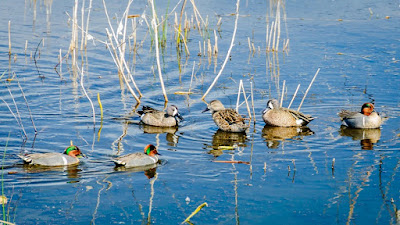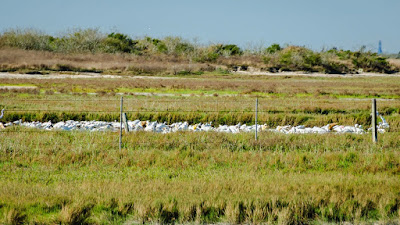We rented a house on the Gulf Coast of Texas for a month and ended up
staying for three months. We knew the birding would be good and the diving bad,
but there were national seashores and wildlife refuges to visit, and coastal
bays and estuaries to kayak. And while we had explored West Texas from El Paso
to Big Bend National Park on the Rio Grande, we had not spent time in the Coastal Bend.
As we descended from the Texas
Hill Country, we were struck by the width (100 miles) and flatness of the coastal plain. It’s barely above sea level – there were hurricane evacuation signs 20
miles from the coast. Nearly everyone we
met assumed we were staying in an RV park and were surprised to learn that we had rented a house. Unbeknownst to us, we came to Texas during “Winter
Texan Season” (Dec-Mar) when people drive to the Gulf Coast from northern
states to escape the cold. It’s also “Whooping Crane Season” when, after flying
2,500 miles from the Northwest Territories of Canada, they arrive to feast on
blue crabs in the bays and marshes of Aransas National Wildlife Refuge.
We stayed in Rockport on the Live Oak Peninsula between Copano and
Aransas bays. It’s contiguous with Fulton and they're often referred to as
Rockport-Fulton (population about 10,000). Five miles across Aransas Bay is San
José Island, a barrier island beyond which is the Gulf of Mexico.
The coastal landscape
is quite young. Most of the estuaries are less than 10,000 years old and sea
level, which was highest 130,000 years ago, reached its current height 3,500
years ago. San José Island is built on a Pleistocene beach ridge (link).
Landforms of the Live Oak Peninsula (and all of Aransas County) are Pleistocene
beach ridges and swales, deflation troughs and stabilized dunes (link), remnants of an ancient barrier island. Upland habitats on the peninsula include woodlands, prairies and freshwater wetlands, which are potholes between
ridges that trap rain runoff.
 |
| Rande and the Big Blue Crab, a local Rockport landmark on Little Bay |
 |
| Rockport Beach on Aransas Bay |
 |
| Feeding laughing gulls at Rockport Beach |
 |
| At 1,000 years old, "Big Tree" on the Lamar Peninsula is reported to be the oldest live oak |
 |
| Green anole in our backyard; sometimes they came into the house |
 |
| Coastal prarie (and longhorns) near Bayside |
 |
| Live oak forest on the Lamar Peninsula |
 |
| Ephemeral pond (pothole) and wetland in Rockport |
 |
| Guadalupe River and gallery forest |
 |
| Once a coastal prairie, this field near Autswell ready for planting |
 |
| Salt marsh on Redfish Bay near Aransas Pass |
 |
| Salt marsh and live oak motte (cluster) on St. Charles Bay |
 |
| Sand flat near Port Aransas |
We visited the Aransas National Wildlife Refuge on the Gulf
Coast north of Rockport several times over the winter. Located on the Blackjack
Peninsula, it comprises 115,000 acres of coastal plain, live oak forests,
barrier island and freshwater and saltwater wetlands. It was created in 1937 by
President Franklin D. Roosevelt as “a refuge and breeding ground for migratory
birds and other wildlife…[and]…for use as an inviolate sanctuary, or for any
other management purpose, for migratory birds…” It rose to prominence in the
conservation movement in the early 1940s when 15 whooping cranes remained in
the wild. Aransas NWR became the focal point of an international effort to
rescue whoopers from extinction (link, link).
 |
| Saltwater marsh at the south end Aransas National Wildlife Refuge |
 |
| Thomas slough with black willows |
 |
| The Jones Lake shoreline was damaged by feral hogs rooting for food |
 |
| Freshwater pond with native prickly pear in the foreground |
 |
| Whoopers foraging on St, Charles Bay [whooper on the right has yellow bands on left leg and (probably) a GPS transmitter on the right leg] |
 |
| Whoopers on the move |
 |
| Sandhill cranes foraging in a hay field |
 |
| Prescribed burn on the Aransas National Wildlife Refuge |
 |
| American alligator at Jones Lake |
 |
| Feral hog at Jones Lake with two alligators |
There several hiking trails, a 9-mile auto tour, observation
platforms, a fishing pier, a picnic area in an live oak motte (but no camping
facilities) and a visitor center that offers tours of the refuge.
Texas has documented 613 species of birds, more than any
other state, and has taken advantage of national and international tourism to
designate trails, bird sanctuaries and nature preserves along the Texas Coast.
Known as the “Great Texas Coastal Birding Trail,” Texas Parks and Wildlife
manages the system comprising 43 hiking and driving trails and 308
bird-watching sites, including road signs at the sites. It began in 1993 and
was the first trail system of its kind in the nation (link).
The concept was so popular that Texas Parks and Wildlife has designated
nine “Great Texas Wildlife Trails” throughout the state (link).
We did a lot of birding in the Coastal Bend, sometimes in our front yard; here are a few pictures.
 |
| Red drum caught from the fishing pier |
 |
| Spanish dagger |
 |
| Black-bellied whistling-duck on an oak tree in our front yard |
 |
| White ibis in our neighbor's yard |
 |
| Black skimmer feeding in Little Bay |
 |
| Marbled godwits (foreground) and American avocets in Aransas Bay |
 |
| Snowy egrets foraging among mangroves of Redfish Bay |
 |
| Roseate spoonbills (foreground) foraging in a marsh on Copano Bay |
 |
| Green-wing and blue-winged teals on Jones Lake |
 |
| Redheads on Little Bay |
 |
| White Pelicans over Aransas Bay |
 |
| The grove of live oaks where great blue herons and great egrets roost and nest |
 |
| Great blue herons (14) and great egrets (9) at the beginning of the nesting season |
 |
| Great blue herons on their nest |
 |
| A few white pelicans (right) are feeding as more fly in; also present are white and white-faced ibis and snowy and great egrets |
 |
| White pelicans, egrets and roseate spoonbills continue to fly in |
 |
| The small slough is filled with feeding birds |
 |
| The party is nearly over by five minutes |
 |
| By six minutes, the slough in almost empty |






No comments:
Post a Comment